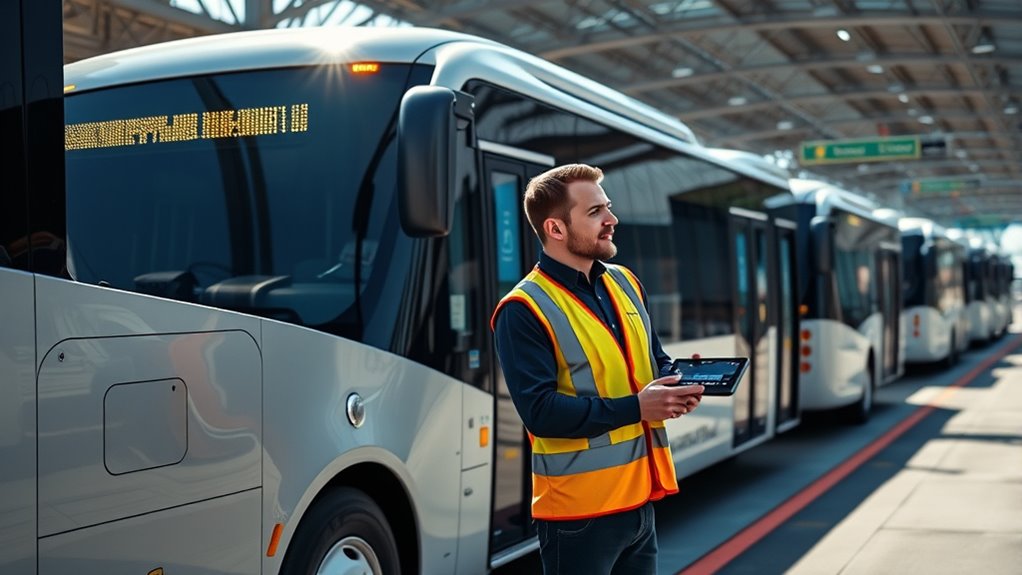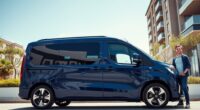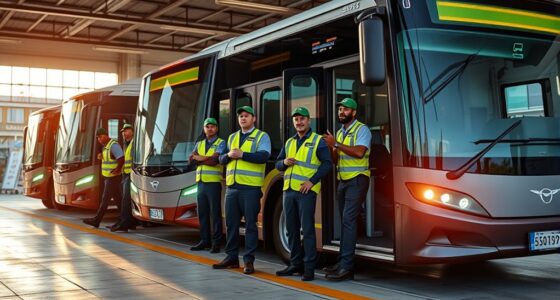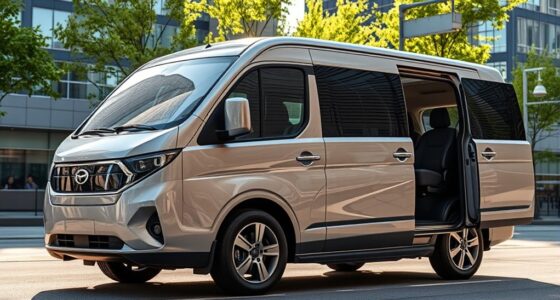Running an electric bus fleet involves balancing high initial costs for vehicles and infrastructure with long-term savings on fuel and maintenance. You need to optimize route planning, implement smart charging strategies, and monitor energy use to keep expenses low. Investing in advanced tech like predictive maintenance and V2G can boost efficiency and revenue. Embracing sustainability boosts your brand and complies with regulations. To succeed, you’ll want to explore how these strategies come together step by step.
Key Takeaways
- Initial high capital costs are offset over time by lower fuel, maintenance, and operational expenses.
- Effective route planning and predictive maintenance enhance fleet reliability and reduce downtime.
- Smart charging strategies and V2G technology optimize energy costs and generate additional revenue streams.
- Infrastructure investments, including grants and renewable energy, are crucial for sustainability and cost savings.
- Continuous technological advancements improve efficiency, safety, and environmental benefits, supporting long-term business success.
Navigating the Initial Investment and Infrastructure Challenges
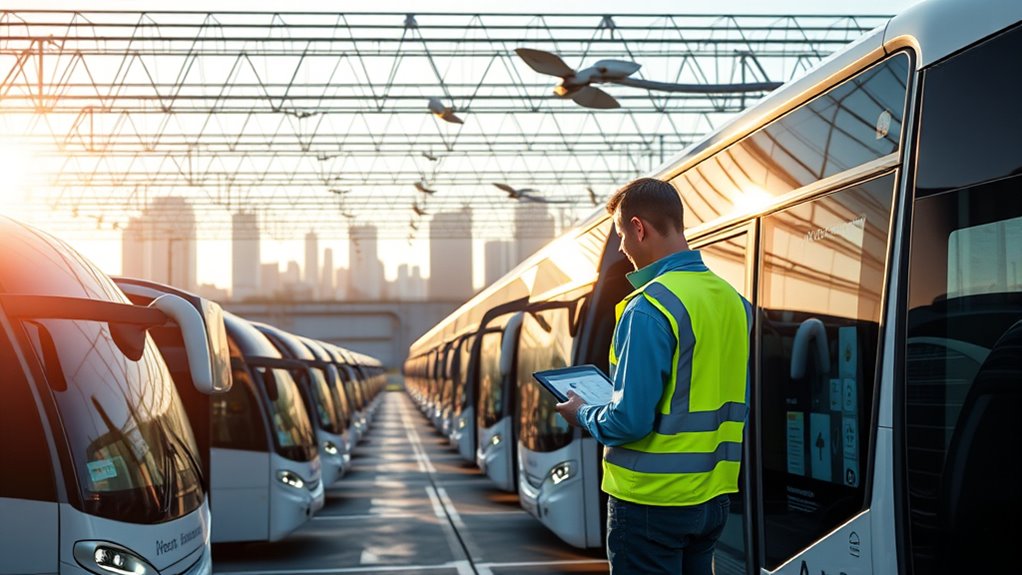
Managing the initial investment and infrastructure challenges is a critical step for fleet operators shifting to electric buses. Electric buses typically cost around $400,000 each, higher than diesel models, mainly due to battery costs and manufacturing scale.
Initial investments for electric buses are higher but offset by long-term savings and incentives.
Grants from federal and state programs, like Volkswagen ZEV funds, can help offset these expenses, but accessing funding sources requires effort and matching funds.
Infrastructure costs vary: basic charging setups cost $10,000-$30,000 per bus, while district-wide depot chargers can reach $400,000. Charging station lifespans (20-40 years) far exceed route contracts, but real estate and upgrades add to costs.
Smart charging hardware can increase upfront expenses but offers revenue opportunities. Proper planning ensures that infrastructure investments support long-term operational goals and maximize funding benefits.
Optimizing Operational Efficiency and Route Management
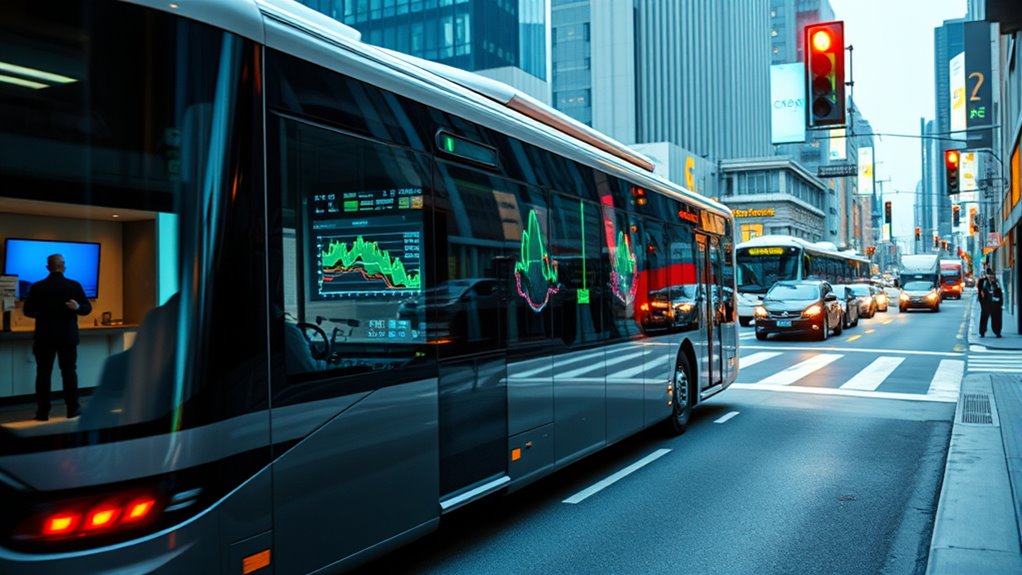
Optimizing operational efficiency and route management is key to maximizing the value of your electric bus fleet. By integrating predictive maintenance, you can analyze real-time data to detect issues early, monitor battery health, and schedule repairs proactively, reducing downtime and repair costs. Additionally, implementing juice cleanse strategies for your fleet’s energy management can help improve efficiency and sustainability. Implementing comprehensive Kia Tuning techniques, such as ECU remapping and suspension upgrades, can further enhance vehicle performance and reliability. Data-driven route optimization allows you to adjust routes dynamically based on traffic, weather, and passenger load, improving energy use and service reliability. Coordinating charging stations with route-specific energy demands and utilizing telematics helps reroute buses during disruptions. Implementing advanced charging strategies, like off-peak and V2G charging, can lower costs and monetize idle batteries. Efficient fleet scheduling through algorithms and peak-demand analysis ensures ideal bus deployment, while resilient protocols and driver training enhance reliability and operational stability.
Achieving Cost-Effectiveness and Managing Energy Expenses
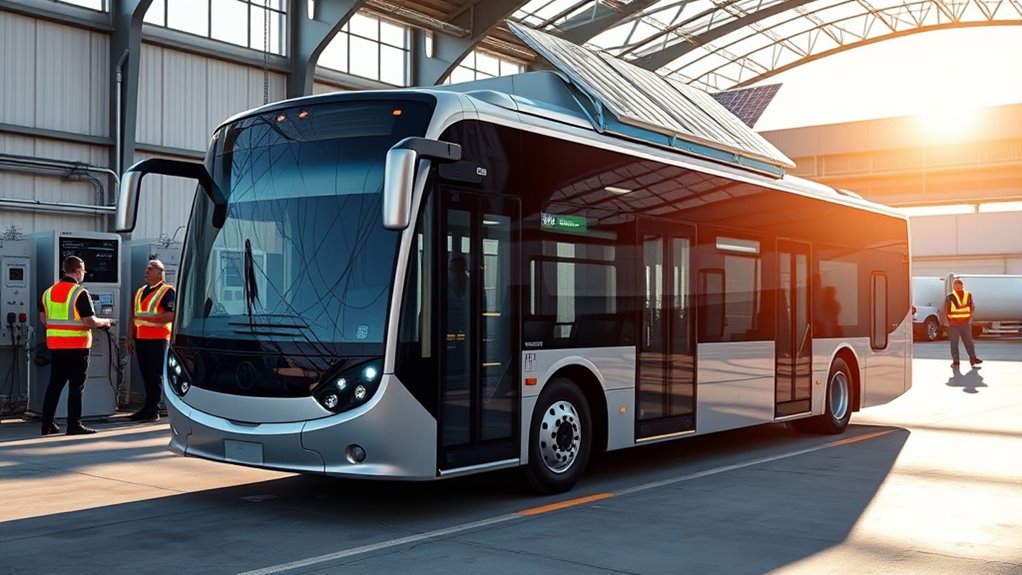
Achieving cost-effectiveness with your electric bus fleet requires a strategic approach to energy expenses and operational savings. Electric buses cost about 2.5 times less to fuel than diesel, with electricity prices remaining more stable, reducing financial surprises. They also cut maintenance costs considerably—up to $125,000 over their lifetime—thanks to fewer parts and simplified systems. To manage energy expenses, implement smart charging strategies that avoid peak hours and explore renewable energy sources to lower costs and reliance on non-renewables. Understanding utility demand charges is essential, as they can impact overall expenses. Additionally, vehicle-to-grid technology can generate up to $6,000 annually. Regular monitoring of energy consumption and staying informed about energy-saving innovations can further optimize operational costs.
Embracing Sustainability and Environmental Benefits
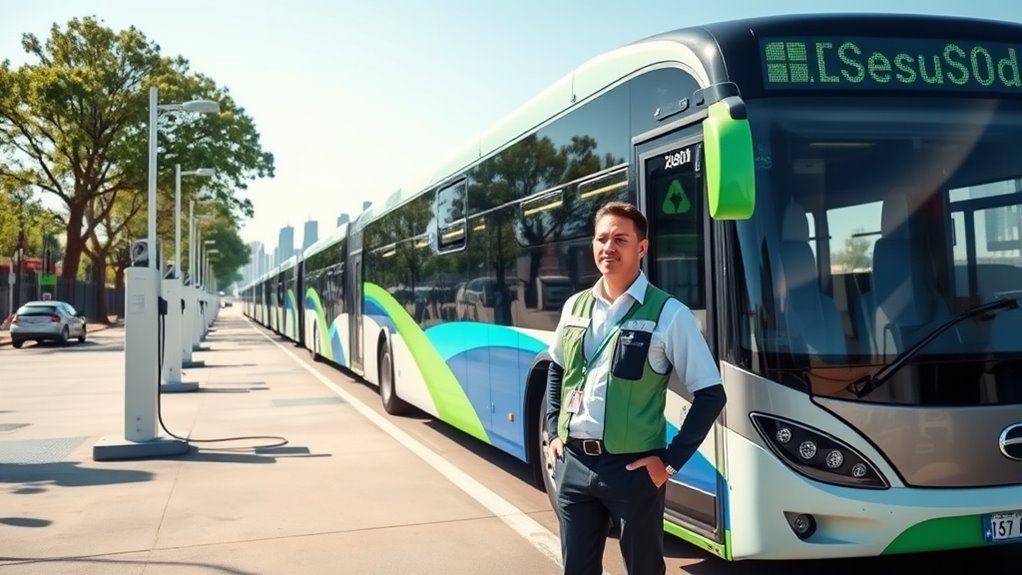
Embracing sustainability and environmental benefits is essential for modern fleet operations, as electric buses play a key role in reducing urban pollution and combating climate change. They produce no tailpipe emissions, helping improve city air quality and decrease particulate matter that worsens respiratory issues.
Electric buses reduce urban pollution and improve air quality by producing zero tailpipe emissions.
Without diesel exhaust, ground-level ozone formation drops, benefiting public health and reducing asthma and other respiratory diseases. Electric buses considerably lower greenhouse gas emissions, supporting climate mitigation efforts. Additionally, adopting advanced projector technology can enhance operational efficiency and passenger experience in transportation hubs.
Implementing regulatory compliance measures and staying informed about changing policies can further support fleet transition to sustainable options. They also help cities meet stricter environmental regulations and enhance urban life by creating cleaner, quieter environments. Additionally, these buses contribute to decarbonization initiatives, support sustainable transportation goals, and often qualify for incentives. Implementing electrification infrastructure is vital for ensuring smooth operation and maintenance of electric bus fleets.
Furthermore, integrating sustainable energy sources such as solar or wind power into charging stations can maximize the environmental benefits of electric buses. Embracing these benefits aligns your fleet with global environmental priorities, fostering healthier communities and a more sustainable future.
Leveraging Technological Innovations and Strategic Planning
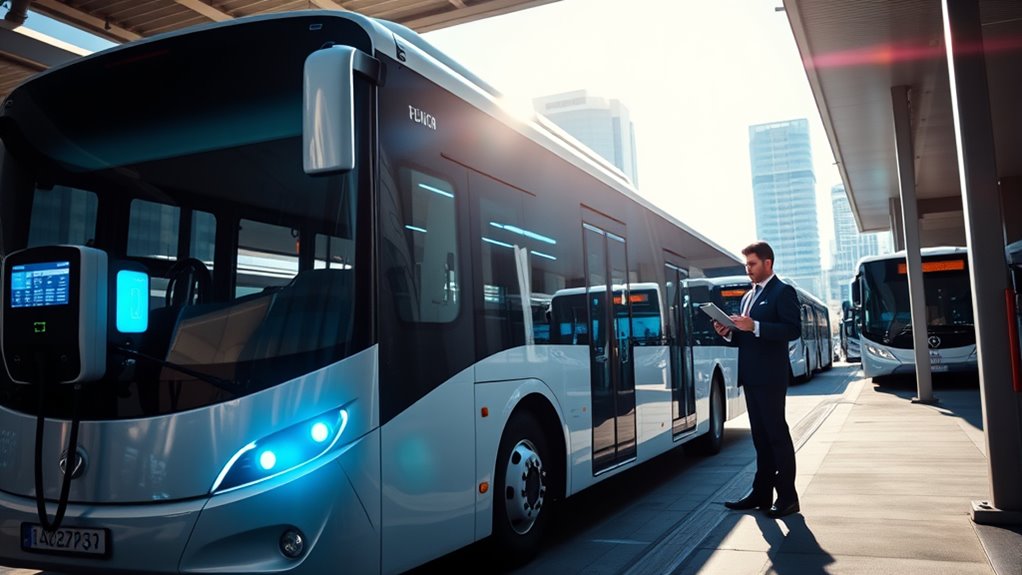
Leveraging technological innovations and strategic planning is essential for modern fleet operators seeking to maximize efficiency and reduce costs. Advanced battery and charging systems, like solid-state batteries and fast-charging tech, minimize downtime and extend vehicle range. Wireless inductive charging at bus stops allows in-route energy top-ups, reducing depot dependency. Incorporating antique-inspired design elements can also create a distinctive and inviting environment for passengers and staff alike. Energy recuperation systems capture braking energy, boosting efficiency. Integrating battery management optimizes lifespan through real-time monitoring. In motor and powertrain efficiency, high-torque motors and regenerative braking cut energy use, while lightweight designs and modular architectures lower operational costs. AI-driven diagnostics enhance maintenance schedules by predicting component failures before they occur. Recognizing symptoms of breast cancer is crucial for early detection and health safety, which parallels the importance of proactive maintenance in fleet management. Smart safety features, such as 360-degree cameras and collision warnings, protect passengers and drivers. Connected traffic lights and predictive maintenance streamline routes and prevent breakdowns.
Frequently Asked Questions
How Can Fleet Operators Secure Funding or Incentives for Electric Bus Adoption?
You can secure funding or incentives by exploring federal programs like the Clean School Bus Program and EPA grants. Check if your state offers grants or rebates, such as California’s HVIP or New York’s NYSBIP.
Partner with utilities for infrastructure grants and reduced electricity rates. Consider green bank loans or leasing options to lower upfront costs.
Connecting with local agencies and utility providers helps identify available funding options tailored to your fleet’s needs.
What Are Best Practices for Training Staff on New Electric Vehicle Technologies?
Imagine your team is about to operate electric buses for the first time. To guarantee success, you should start with thorough hands-on training, including virtual courses and manufacturer support.
Focus on key areas like high-voltage safety, battery management, and troubleshooting. Regular ongoing education and collaboration with industry peers help keep skills sharp.
This approach minimizes risks, boosts confidence, and guarantees your staff is well-prepared for the shift.
How to Effectively Communicate Environmental Benefits to Stakeholders and the Public?
To effectively communicate environmental benefits, you should highlight how electric buses reduce greenhouse gases and improve air quality.
Use clear visuals and simple language to show community health improvements and long-term savings.
Share success stories and data on emissions reduction.
Engage stakeholders through meetings, social media, and public campaigns, emphasizing how electric buses contribute to sustainability goals.
This builds trust and demonstrates your commitment to a cleaner, healthier environment.
What Are the Key Factors for Selecting the Right Charging Infrastructure Suppliers?
Choosing the perfect charging infrastructure supplier might feel like searching for a needle in a haystack, but it’s vital. You need a partner who understands your power needs, offers lightning-fast chargers, and guarantees unwavering reliability.
Look for scalable solutions, top-tier support, and cutting-edge tech that future-proofs your fleet. Environmental compliance, safety standards, and cost efficiency are essential.
Your ideal supplier should make charging seamless, safe, and ready for growth—no matter what the future holds.
How Can Fleet Managers Monitor and Improve Electric Bus Performance Over Time?
You can monitor and improve electric bus performance by leveraging telematics and advanced sensors to gather real-time data on vehicle operation, energy use, and battery health.
Regularly analyze this data to identify patterns and potential issues, enabling predictive maintenance.
Use insights from performance evaluations and battery analytics to optimize routes and charging schedules, ensuring maximum efficiency and longevity.
Continuous monitoring helps you make informed decisions that enhance fleet reliability and reduce costs over time.
Conclusion
So, congratulations—you’re now officially part of the electric revolution, even if your wallet’s groaning a bit. Sure, the upfront costs might make you reconsider your life choices, and the charging stations could be your new favorite headache. But hey, at least you’re saving the planet while juggling route schedules and energy bills. Just remember, in the end, who needs profits when you can boast about being the coolest, most eco-friendly fleet on the block?
